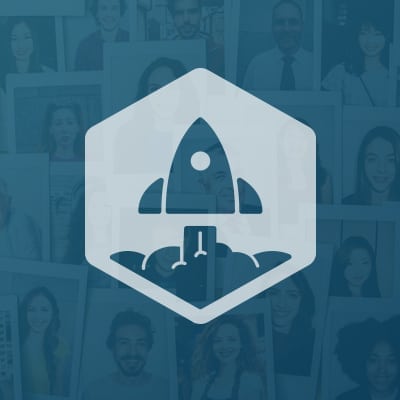Taking a company to unicorn status is tough enough as it is, but what about doing it twice? Harry Stebbings, Host of The Twenty Minute VC and SaaStr podcasts, moderates this session with David Steinberg, CEO at Zeta Global, who tells us about the hard-learned lessons he picked up throughout his exciting journey with Zeta.
He gives his thoughts on evolving your company’s vision as it grows, the importance of being flexible and pivoting often, failing very fast when it comes to salespeople, why machine learning is the way of the future and choosing your battles instead of being a control freak.
And if you haven’t heard: SaaStr Annual will be back in 2018, bigger and better than ever! Join 10,000 fellow founders, investors and execs for 3 days of unparalleled networking and epic learnings from SaaS legends like Eric Yuan, Tomasz Tunguz, Chris O’Neill, and Mikkel Svane. If you don’t have tickets, lock in Early Bird pricing today and bring your team from just $799! (All ticket prices go up November 1st.) Get tickets here.
TRANSCRIPT
David Appel: Good afternoon, or good morning still, everyone. My name is David Appel. I’m the head of software and SaaS Vertical at Intacct. Intacct helps companies know their key metrics by automating core financial processes so you can dominate your market.
This is our second session of the day here on the tactical stage. I’m excited for what this session is. It’s a great topic, “Seven and a Half Lessons I’ve Learned in Building My Second Unicorn.”
Great panel. Harry Stebbings is going to be moderating. For those of you who don’t know Harry, Harry is in charge of “The Twenty Minute VC” podcast, over 130,000 subscribers. For those of you who are part of it, fantastic. Those of you who aren’t, allow me personally recommend it.
Harry is going to be interviewing David Steinberg. David is the CEO of Zeta Interactive. I’m going to leave them to share the story about why this company is so fantastic. Whereas we were talking and prepping a little bit before the session, there’s something we wanted each of you to walk away with, which is how to think about solving big problems, how to build the culture to solve big problems, and then how do you exude the confidence in your customers that you can solve those big problems.
With that, I’m going to let them tell their stories. Harry? And David.
[applause]
David Steinberg: Thanks, David. Good thing it’s so bright up here.
Harry Stebbings: I know, right? David, I want to start today with a bit about you and a bit of context. Now you’re running Zeta Global, CEO, tell me the backstory and why you’re sitting in this chair and I have the pleasure of interviewing you?
David: Well, that’s a question my kids ask me all the time. “Why do people even care what you have to say?” Zeta Global is now the fifth largest marketing cloud in the world. As my partner John Sculley says, “We’re the largest big data and analytics company that nobody’s ever heard of.”
Harry: Absolutely, I want to start this, though, with something we hear a lot about and it’s the importance of vision. Often, we’re told, “You must have the overarching vision that stays with the company always.” What’s your thoughts on vision and the importance of having it from the very start and an immovable vision that doesn’t change?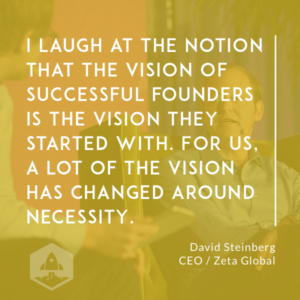
David: Well, I laugh that all vision for founders who become very successful becomes the vision they started with, even though it generally wasn’t. For us, we didn’t start off with this vision to build a customer lifecycle marketing platform, we really started off with the vision to make data actionable. How do we take clients’ data and convert it into either customer acquisition, retention, or monetization?
If you look at companies like Uber, which started out owning cars before they became a platform company, or Netflix, which started out shipping DVDs, the vision today, of course, was always to be a platform, or be a VOD, but those early pitches probably didn’t read like that.
Harry: How have you seen your vision change then, when you look at the early days compared to now, the fifth largest, as you’ve said?
David: A lot of the vision for us has changed around necessity. I joke that great companies have to pivot very, very frequently, and no matter how big you are you have to continue to pivot, and pivot regularly. Our vision has really changed, a) because it’s what our clients want to buy versus what we thought they wanted to buy initially, and b) technology.
If you look at Moore’s Law, you look at moving to the cloud, you look at cost of storage, more data will be created in the next day than was created in the hundred years leading up to this year. It’s unbelievable that a lot of that data’s always been created, but it was cost prohibitive to store it, and it would take you forever from a processing power perspective to process it.
Usually at this time, I’ll hold up my iPhone and say there’s more processing power in the iPhone than was in every machine used to send man to the moon in 1969 combined, including the ship and the center in Houston. That’s really driving the data and analytics space.
Harry: You said pivot there, that’s often something that I hear in interviews with VCs of portfolio companies. I’m intrigued. How do you define pivot? Is it a small little transition away from the core, or is it a monumental transition?
David: The pivot changes depending on your size. The bigger you are, generally, the smaller your pivot, but they’re still pivots. For us, seven years ago…we just turned 10 years old, so as I jokingly say, we’re a 10 year old, overnight sensation. But literally, seven years ago, we were an education marketing company, primarily focused on the for profit education space.
Little bit of regulatory reform came into that space and we pivoted pretty hard to become a SaaS-based, data and analytics platform. That was a necessity. If we didn’t do that, we would have gone out of business. As you’ve looked at other pivots we’ve done, from customer acquisition, we’ve added CRM and integrated the two into one solution. That was a pivot and they keep going.
Harry: I’m intrigued then. With experiencing both pivots, what do you think it takes to really navigate a pivot successfully and really do that onboarding well?
David: It doesn’t take as much when you’re really screwed, right? If you’re really in bad shape and you’ve got to pivot, you kind of go for it. It’s a very low opportunity cost transaction, but really you have to be flexible.
One of the things I think to be a good founder and be a good CEO, you have to have a level of grit and tenacity to keep things going. But, you also have to be flexible enough to know when something’s not working.
It’s almost like a little bit of an art form. I certainly was not good at it early in my career. This is my fifth company. I sold three, took one public, then founded this. It took me until this organization to get to the level of flexibility that I have.
Harry: How do you learn to balance that grit and tenacity with then potential stubbornness. Is it the role of board members? Is it looking at ARR going like, “That’s going down and we’re a SaaS business?”
David: As I said, it’s more of an art than a science, Harry. It’s very hard to define it. There are great stories about founders who have totally gone against their board and won.
But, there are more stories about guys who have respected their board, put people there that they trust and respect who have sat down with them and helped them.
I used to be the youngest guy in the room. Now, often, I’m the oldest, so I do a little bit of my own kind of self realization and what’s working and what’s not working. We have a mantra, for example. We’re very big on investment into salespeople. Very big.
We’ve always invested very heavily in that at Zeta and not as heavily in marketing. We haven’t built a big household brand versus our size. But, when I look at a salesperson, we have a longer sales cycle than most products, but I build a P&L on every salesperson.
We have a red, green or orange. If somebody’s in the green, they keep going. If they’re in the orange, we got to sit down with them and if they’re red, we fire them. It’s a six to nine month period that we want to fail very fast with salespeople.
Harry: How do you benchmark them then? What is that kind of process look like that defines red, green?
David: We have kind of the first three months is pipeline based. The next three months is converting from RFP into getting into the final stages of a process.
Going into the next three months, if they haven’t closed at least three transactions and are breaking themselves even on their income, they go right to red.
Harry: So, if you pay back times nine months.
David: Pretty much. We’ll be flexible around that if we have somebody we think is a rock star that could go longer, but generally we’re very, very disciplined about it.
It’s funny because we sit down with salespeople, and I don’t do a lot of that myself anymore, but I know the team does it. We effectively will pay them whatever they want. Say, “This is what I need to make.”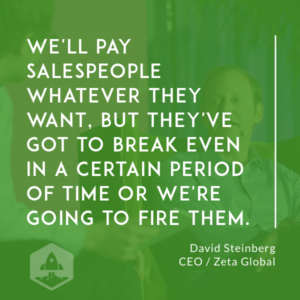
“OK, but here’s the deal.” [laughs] You’ve got to be able to break yourself even in this period of time or we’re going to fire you.
Harry: You’ve run five companies now and scaled sales teams immensely successfully. What is building that internal sales structure look like then for you when you compare it among the five that you’ve done?
David: It’s been different because the first three companies were mobile distribution platforms, then the next company was an online e-commerce platform to activate and sell wireless phones, and then this was more of an enterprise sale.
This was a bit of a pivot for me to go from kind of what was a business to consumer platform companies to what was really an enterprise platform company. We learned a lot along the way about the difference between what people say and what they do.
It’s something that I think, even as a founder, we tend not to focus on as much as we should because we give…I give. I shouldn’t say we, but most of the founders I know give people so much of the benefit of the doubt.
I’ve become much more disciplined about that and formulaic about how we build these teams, how we pay them, how they can make money. We have tons of salespeople who make seven figures a year. Tons!
We love that because of the way we structure our comp plans, it means they’re generating millions of dollars in profit for the organization.
Harry: When they’re getting to those seven figures, it’s often a question I get asked by SaaS founders in terms of do we go for lots of logos and lots of clients or do we go for the big Dropbox, Box, Marketos?
What’s your take on this and building that confidence?
David: We’ve always been focused on working with customers that we think can really scale. We have 570 customers, the vast majority are in the Fortune 1000.
Our whole pitch to a customer is, “Hey, if you do a $50,000 test on our platform for a month, if we can’t cut your cost to create a customer by at least 25 percent, we will give you all of your money back.”
But, we’re doing that in a way that we’re trying to work with companies and I’m not technically supposed to talk about brands. Our website has all of ’em, but 10 of the top 40 advertisers in the world use our platform. These are household brands, household names.
One of our customers alone spends $4.3 billion a year globally on marketing. When they start with us at $50,000 and we can really prove ourselves from a platform perspective, they’re kind of coming in through our DMP at the top and using different product sourcing and then deployment, that’s a customer, in particular, that went from $50,000 a month on a test in 2015, did $8 million in business with us in 2016, and will be well over a million a month in 2017.
Harry: Would you always advocate for a variable pricing mechanism whereby as your customers scale their business, your revenues scale too? Or is there certain cases where it’s not actually applicable?
David: It depends on your product. We sell our product as a self serve or a managed service. When somebody buys the product from us on a self serve, they’re effectively taking the platform and just running it. The vast majority of our clients use us more on a managed service basis.
We compete with a few small companies like IBM, Oracle, SalesForce, and Adobe. But most of those guys don’t really sell a managed service product at this point. We take a different tack. We come in and we say, “We can do this for you.” Then if you want to make it a self service product later you can bring it in house. We’ve even put our people in the offices of some of the largest companies in the world to help them with this stuff.
Harry: I’m really intrigued. You said obviously about your competitors and the ACVs that you are looking at. When you’re a small startup, how do you navigate those very large ACVs and large sales cycles with often the very short runway that you might have in terms of 12 to 18 months of funding? Is that a…
David: It’s tough. We started out more focused on customer acquisition, which is we were tapping into the marketing dollars, not the CRM dollars. That allowed us to scale the business pretty quickly. We then acquired eBay’s enterprise CRM business. We acquired Axiom’s email services business. We’ve acquired a number of really high end SaaS based CRM assets, merged them into our marketing cloud, and then we were able to really scale that up from there.
Harry: I’m intrigued though, also, because you said obviously about IBMs and SalesForces. Bigger brands potentially than Zeta Global right now.
David: Just a little.
Harry: Just a little bit. But I’m intrigued to hear then how you assess the importance of B2B branding and when you’re selling to CIOs at huge companies, is it really that fundamental to have a fantastic blog?
David: Listen. We think both those companies are great companies and we cooperate with them just like we compete with them all the time. First of all, IBM has built their brand over 50 years. Pick a number. Maybe it’s a little longer. I think it started in ’61. SalesForce has been around substantially longer than us as well. Marc has done an exceptional job building an amazing company with a great brand.
We came at it another way. I want to remind you, we’re only nine years old, so we haven’t been around as long as the other guys. We started off with a real focus on building product and getting it in front of the customer, versus building brand. I think that was a very purposeful decision.
Although this week I was on the “Today” show Monday morning. The “Journal” wrote an article on us Tuesday. “Fortune” published an article on Wednesday and I’m here Thursday. The PR guys are pushing the crap out of me to get out there and do this stuff.
But the reality is that we definitely are a bigger organization than our brand is recognized.
Harry: If you were to have your time again, would you start the branding exercise earlier, potentially?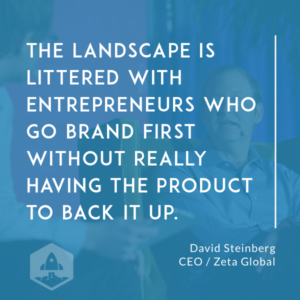
David: Hindsight is 20/20. Maybe, yeah, I would have started a little earlier on the brand, but I do think that entrepreneurs who go brand first and not really have the product to back it up…the landscape is littered with people who have done that.
Harry: Absolutely. I do also, before we go into a quick fire round, which is one of my favorites, I want to discuss, as we said, five businesses. I want to discuss how you’ve seen the marketing landscape alter, especially now with the integration and role that data plays in marketing. How have you seen that develop with your time spent in the space?
David: My partner, John Sculley, who used to run Apple and was the CEO of Pepsi at one point, we do a great talk, we did it at Web Summit this year, “From the Pepsi Challenge to Big Data.” You’ve gone from this “Mad Men” ecosystem to an ecosystem where you’ve got quant jockeys running billion dollar marketing budgets.
You’re just seeing the way people think about digital marketing versus analog changing. I say this all the time and I think it still surprises people. 70 percent of all marketing dollars globally this year are going to be spent in an analog fashion – TV, radio, print, direct mail, and outdoor advertising. It dumbfounds people.
Now, the US is a little skewed more to digital, but I’m talking global dollars. We think over the next 10 years those numbers are going to juxtapose. You’re going to go from 30 70 to 70 30. We truly believe and it might sound contrite at this point, but we’ve been saying it for two years and have a ton of patents around it, we believe machine learning is going to be really the next big evolution in marketing and CRM.
We have multiple patents around it. We’ve been really focused on it. We have 700 full time engineers working in the company alone, not including everybody else we partner with and other companies we’ve strategically worked with on that stuff.
Harry: How does the integration of machine learning into marketing routines, then, affect the role of CMOs, scaling, and earlier stage marketing teams?
David: It’s going to push things further up the funnel. Whereas today, everybody’s trying to get to the bottom of the funnel as fast as they can, what we argue is you’re getting to the bottom of the funnel but you’re doing it primarily on just simple behaviors.
The example we give is, we actually already have a platform that sorts through every mortgage application in the United States every day, cross references it to make sure that they’re not filling out a mortgage application in the same ZIP code in which they currently live.
We then bounce it up against our database of 350 million active people, which then sorts to one of our clients’ databases and it’s highly probable that that person is going to be moving, obviously. It puts it at a 78 percent likelihood that they’re going to be changing alarm companies.
You wouldn’t really think that somebody who’s filling out a mortgage application would drive an alarm company decision. But it’s an example of what I call a disparate behavior leading to a very logical answer. Because when I tell you that, it sounds like “Yeah, that makes sense. They’re moving. They probably don’t think to bring their alarm with them.”
We’ve now designed an entire package to help them bring that alarm with them to their new property. We’re reaching out to them before they’ve ever even contemplated what they want to do with an alarm. They’re still thinking about curtains, right?
Harry: You’ve mentioned John Sculley a couple of times. Before, as I said, we dive into the quick fire, I do want to hear, what’s been the big learnings for you from working side by side with him and building Zeta Global and the big takeaways?
David: This is John and my’s third company together. He and I joked the other day when he first met me, I was the young guy. Now I’m the old guy. But John’s regressing. He keeps getting younger and I’m getting older, so we’re catching up with each other.
He is the most brilliant marketing person I have ever known. He is literally…the things that he understands just intuitively about marketing, about people, they are things that I would’ve never come to the conclusion without him there behind me helping me.
Harry: I do want to do the quick fire. We normally do this on the show, but considering that this is in person, I get to do this in person. Team construction, what are the first three hires for you? 60 seconds.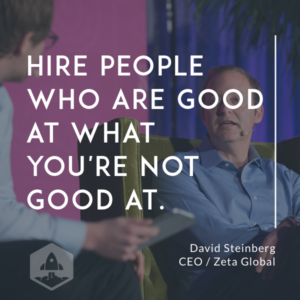
David: For me, 60 seconds, hire people who are good at what you’re not good at. I’m horrible at detail orientation. I’m very ADD, so I jump around a lot. I invest very heavily early in great finance people and great operating people. That might be counter intuitive, but that’s where I invest early. I tend to get the sales stuff done myself early in the organization.
Harry: Do you think founders should sell up to 1 million ARR, as Jason always proclaims?
David: I think founders’ jobs are to do nothing but sell. You’re selling great human capital to join you. You’re selling clients to buy your product and services. Then you’re selling the marketplace on your brand. It’s the ABCs, always be closing. Often, you’re selling different things.
Harry: Absolutely. What’s the biggest challenge today, daily, with Zeta for you?
David: We’re 1,400 employees operating out of 26 offices on four continents, with a big campus in Hyderabad, India. It’s just keeping up with the time zones. I technically, personally, live between New York, DC, Miami, and California and spend the average months cycling through all of those cities pretty regularly.
Harry: Sales cycles. You have incredible ACVs of, say, 500K plus. Sales cycles, according to my research, are about three and a half months. What’ the secret with such large ACVs and relatively short sales cycles?
David: Let’s be clear. The sales cycle on the acquisition component of our business, the ZX part, is pretty fast because you’re doing a $50,000 test. If it works, they scale very quickly, because you’re showing a 25 percent lowering of cost to create a customer. If it doesn’t work, you figure out why and you try to pivot that. On the CRM stuff, we actually use the acquisition relationships to circumvent processes that they would normally go on going out to RFP.
When we go into a traditional RFP process…Gartner puts us as one of the 10 best companies in the world for what we do. Forrester, Relevancy Group, Red Pill put us one, two, or three globally for our marketing automation platform. It’s a much longer cycle than three months. You’re talking about almost a 9 to 12 month cycle on some of these big CRM contacts.
Harry: You said before about building intrapreneurs, entrepreneurs within large organizations. What’s the secret to doing that and creating that culture?
David: First of all, it’s got to come from the top. You’ve got to have the self confidence as a founder to empower people to a level that you will actually be uncomfortable with, at least me, because I’m a control freak. When I looked at that, it’s empowerment and then it’s, “How do you pay people?” We push P&L responsibility down in our organization as far as we possibly can.
When people feel like, if they’re going to create a dollar and profit for the organization, if they’re going to make five percent of that, they’re going to be really motivated to drive, not just revenue growth, and not just logo growth, but drive profit growth.
Harry: What do you know now that you wish you’d known at the beginning?
David: I wish I wasn’t such a control freak when I started 24 years ago. I have gotten into a number of juvenile battles with boards and other employees over the years because I knew I was right. Even though I was right, it wouldn’t have mattered…
[laughter]
David: …because these were small things, right? It was like, “Pick your battles.” I’m now kind of, “Let’s test it. Let’s see if it works.” The great thing about today’s business ecosystems, you can test things that you couldn’t test 20 years ago. When we set up our first website at Sterling Cellular, I think we spent $2 million to build a website. [laughs] I’m not kidding. It was insane.
Harry: When was this?
David: This was 1997, 1998. We were buying servers and rack systems. We had a very early version of a credit card processing system. Nobody used it. It was just funny. Today, you could set up that exact same site with Squarespace or GoDaddy and be in business in two or three days for $5,000. [laughs]
Harry: Final question, what’s the big prediction for the marketing landscape ahead with the role the data will play?
David: Machine learning. This is all going to be about machine learning. A lot of people are talking about artificial intelligence. You’ve got Google, and Facebook, and a couple of others, IBM, of course, talking about how they’re out there. I still think we’re in the very, very advanced machine learning age. We’re not near AI yet. It’s still cost prohibitive for the average client to be utilizing a supercomputer to figure out how to lower their churn rate.
We’re working with them on doing that. I believe that us or somebody else will crack the code on machine learning around customer acquisition, customer retention, and customer monetization. It’s going to be the future of our landscape.
Harry: Well, David, it’s been such a pleasure getting the chance to interview you. Thank you so much.
David: Thanks, Harry. I appreciate your time.

